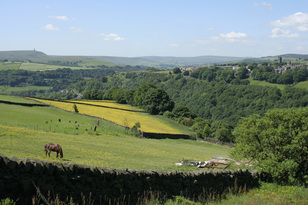
Calderdale & Stoodley Pike ©Georgina Collins
The South Pennines are situated in the heart of England and can offer great days on the hill but are relatively unknown in the hill-walking world. For this reason we asked Neil Collins of the
South Pennines Campaign Network to tell us more about some of the hill-walking opportunities of the South Pennines and why he and many others think that the area should have National Park status. A special thanks to Georgina Collins for providing the great images in this article: for more pictures taken by her please visit her Flickr site at
www.flickr.com/photos/georginah. Read on, I promise you will learn something...
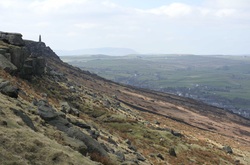
Earl Crag, looking to Pendle Hill ©Georgina Collins
The South Pennines is that part of the Pennine chain that lies between the Peak District and the Yorkshire Dales. It’s actually a slightly misleading name, as the Peak District forms the southern end of the Pennines, but it appears to have stuck. Like the Dark Peak immediately to the south, its geology is dominated by millstone grit, although there are small pockets of limestone around Lothersdale, and to the north of Pendle Hill. The dominance of millstone grit has resulted in a landscape that is very similar in many ways to that of the Dark Peak, with extensive tracts of peaty moorland, outcrops of gritstone (like those at Blackstone Edge and Earl Crag), and weird rock formations, the Bride Stones in the Cliviger Gorge being the most dramatic.
As the area that I grew up in, it’s long been a favourite of mine for hill-walking. The moors can be quite hard going at times, despite their proximity to the large industrial towns of northern England, as paths tend only to exist on the most popular routes. What this does mean though, is that it takes very little time to get right away from it all. Blackstone Edge, right at the southern end of the range, is a great example. You can walk from the ever-popular Hollingworth Lake Country Park, just outside Rochdale, and within less than an hour, you can be standing on the summit of the hill, looking across acres of rolling moorland. From there, you can walk southwards and return to Hollingworth Lake via the Windy Hills ridge, or you can head across to Yorkshire via Rishworth Moor or Buckstones Moss if you fancy some real bog-trotting!
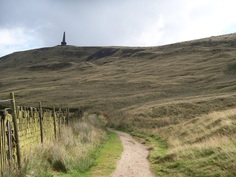
Stoodley Pike ©Georgina Collins
A favourite hill of mine is Stoodley Pike, above Calderdale. A great approach to this hill starts from Cragg Vale (famous for its eighteenth century coiners), and continues from the summit monument via Higher House Moor, White Holme Reservoir, and Great Manshead Hill. This is one of the few opportunities in the South Pennines to do a genuine ‘horseshoe’ walk, although you may find that the ground is a little wetter than on the Fairfield Horseshoe! Moving to the north of Calderdale, you come to the hills that are probably the remotest in the group.
Of these, Boulsworth Hill is the highest (and second only to Pendle Hill in the whole range), and the view from its summit is simply stunning. For many years, the only permitted route was from the north, traditionally walked from Wycoller Country Park, often taking in the rocks at Foster’s Leap, and the lovely waterfall at Lumb Spout en route. Although this is a great walk, it’s now also possible to walk from the south, perhaps starting from Hardcastle Crags and walking via Great Edge and the Dove Stones, which allows for a much longer, and arguably more rewarding day out.
The western end of the range is famous for the Three Towers of Lancashire Walk, taking in Rivington Pike, Darwen Tower and Peel Tower. This area also saw a mass trespass onto Winter Hill in 1896, over thirty-five years before the much more famous Kinder Trespass, proof if any were needed that it’s a great area for walking.
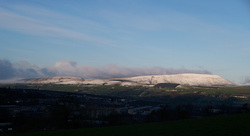
Pendle Hill ©Georgina Collins
Undoubtedly the most famous of the South Pennine hills (and justifiably so) is Pendle Hill, which at 1831 feet, is also the highest. The area around Pendle is renowned for the infamous witch trials of 1812, and this notoriety has no doubt contributed to Pendle’s relative popularity. All routes up Pendle are fantastic, but if pushed to pick a favourite, I would have to go for an ascent from Barley via Ogden Clough, returning via the ‘tourist path’ down the Big End. The view from the summit is emormous, taking in many of the South Pennine hills, the Forest of Bowland, the Lakeland Fells, the Three Peaks, and even Blackpool Tower.
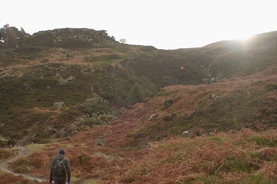
On Ilkley Moor ©Georgina Collins
Almost as famous as Pendle, even if it’s only due to the song, is Ilkley Moor. This is a truly fascinating hill to walk on, and there are so many paths that I can’t really pick out one ‘must-do’ walk. To see the best of the moor, you should really try to visit the Cow and Calf Rocks, the Rocky Valley, the summit (of course!) and some of the many prehistoric remains, the most interesting of which is undoubtedly the Swastika Stone. A few miles east of Ilkley Moor is the much smaller Otley Chevin, which is great for a quick ‘hill-fix’ if you’re short on time. The views are out of all proportion to the hill’s modest height (919 ft), and even inspired a Turner painting.

The
South Pennines Campaign Network was established in 2011 to campaign for National Park status for the area. We believe that the area’s breathtaking moorland scenery is justification enough, as anyone who tries any of the walks suggested above would agree. And we’re obviously not alone in our views, as the scenery was a major influence in the work of the former poet laureate Ted Hughes, the painter JMW Turner, and most famously, the Bronte sisters. Not only that, but George Fox was inspired to start the Quaker religious movement after an ascent of Pendle Hill. It’s also a great area for wildlife, being the favoured English breeding ground of the endangered twite. (This is the bird that is pictured on SPCN’s logo). The range is also renowned for its historical remains, both ancient and industrial. Ilkley Moor is believed to possess the highest number of archaeological remains of any British mountain, and the area even boasts its own World Heritage Site, at Saltaire. For more information on the campaign, or on the South Pennines, please visit our
website.
Thanks for reading this article by Neil Collins on the South Pennines and I hope it has encouraged you to visit the South Pennines some time soon. In the meantime do you live in an area that you think should be better known? We want to hear from you, comment below!






 RSS Feed
RSS Feed

